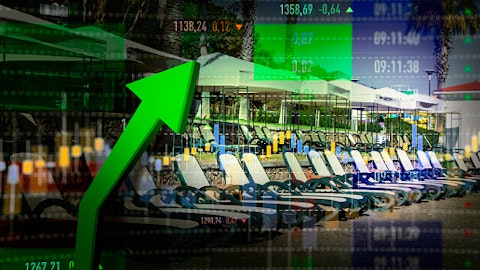Steven Cahall: Great, thank you.
James Ryan: Thanks, Steven.
Operator: Our next question is going to come from Nick Zangler with Stephens Inc. Nick, your line is open.
Nicholas Zangler: Hey, everyone. Thanks. First off, man, do I wish I received compliments like you just received from the artifact investor there. So — it’s always nice to hear and nice of them to do so, I’d say. But if you — and to the question here. If you strip out Autos contribution to growth in the quarter, which I imagine this back of the envelope math is pretty sizable, assuming Autos may be 20% of the mix at this point and obviously growing 20%. Just curious how you gauge, I guess, local performance in the quarter and the outlook stripping out Auto? And if there’s really any other verticals to call out that is contributing to the growth outlook and commentary?
James Ryan: So we’ve said consistently for multiple quarters, Home improvement has continued to be very strong quarter after quarter. Q2 is no different. And our expectations for Q3 for that is not different as well based on a long track record. And as we’ve also commented for the last — at least a year, if not longer, legal has done exceedingly well. So you’re right. Part of it is a story about Auto rebound, which we had said for a long time would eventually happen, and guess what, it did. But there’s also, again, other bright spots, some categories that you would expect, like fast food, probably a little challenged, but that’s been challenged for longer now than I can remember. No surprise there and things like that. And again, I think that new local business development month after month, quarter after quarter is — I mean that’s basically not Auto, that’s mom-and-pop growing business is good old-fashioned way.
Nicholas Zangler: Got it. That’s helpful. And then I did want to talk on the sports rates because you guys kind of brought it up. But basically, I’m wondering if you’re able to provide really any details on the structure that you’ve got with the Phoenix Suns and Mercury. And perhaps alternatively, you spoke to just many different types of structures these sports deals can take. I’m wondering maybe if you could just actually just walk us through that. Like what types of structures do you see, just like whether or not there’s typically fixed payments, potential advertising rev share agreements, just anything to kind of help us understand what these structures look like as potentially more are to be announced as we push forward?
PatLaPlatney: So I’ll start. It’s Pat. There are an infinite number of ways you can structure these deals. There’s variances in distribution, whether it’s all over the air, whether it’s some over the air, some cable, some direct-to-consumer, some over the air with direct-to-consumer. There’s a lot of ways that can be played. There are differences in the way — ways the inventory gets sold. Does the rights acquirers sell the inventory. Does the team sell the inventory, who does the production. Is there pre and post, there’s just a ton of different variables, that impacts those types of discussions. And I think we’re at a point where all of — that’s sort of starting to get figured out, but it’s a very fluid situation. And as is the Diamond situation, and we’re just monitoring where we need to monitor. We’re acting where we need to act, and — but we do believe there will be opportunity there.
Nicholas Zangler: Got it. And then, all right. Last one for me here, just on political, given I think some estimates are coming out maybe $11 billion in this cycle, maybe $12 billion for the cycle. And obviously, the potential for there to be some pull forward, I guess into 2023. As you look across your markets, are there any maybe worth highlighting where you are seeing political ad spend at this point in time significantly above or just different from what you would have seen at this point in time in the last Presidential election that might be a leading indicator of just how large is the spend might be as we think about the whole cycle? Thanks.
Kevin Latek: Short answer is, no. People aren’t really advertising outside of the — for early primary states to any noticeable extent. I mean, look, it’s still getting any money now for Presidential primary is still a big deal. That’s why Iowa is doing really well. In the other states that are generally performing well. Our Governor’s race in two states, State House race in Virginia. And then there are some issues that have popped up from time to time, but Presidential primary money has historically been — in ’19, it was a fourth quarter event. It’s now happening a little early, but it’s happening in the primarily Iowa for us.
Nicholas Zangler: Got it. Thanks guys. Appreciate it.
Hilton Howell: Thanks, Nick.
Operator: [Operator Instructions] Our next question is going to come from Alan Gould with Loop Capital. Your line is open.
Alan Gould: Thank you. First question, Kevin, can you drill down a little bit more about what the affiliate boards are going to negotiate to get the virtual distribution? Any benchmarks we should be looking for? Are you trying to literally change laws? What’s going — can you just give us some more details there?



